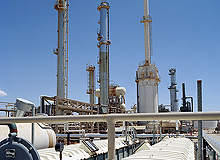
The Navajo refinery is comprised of two facilities at Artesia and another at Lovington in New Mexico, US. The two facilities operate in conjunction and are considered to be a single refinery. The total capacity of the Navajo refinery is 100,000bpsd. Its main products include gasoline, diesel and jet fuel.
The refinery is owned and operated by Holly Corporation.
Construction and infrastructure
The Artesia facility is spread over 561 acres and has been operating since 1969. It has crude distillation facilities, a fluid catalytic cracker (FCC), vacuum distillation equipment, catalytic reforming and sulphur recovery units. It also includes hydrofluoric (HF) alkylation, hydrodesulphurisation, isomerisation and product blending facilities.
A tank farm with a feedstock and product storage capacity of 0.2m barrels is also part of the facility. Other infrastructure at the facility includes warehouses, maintenance facilities and office buildings.
The Lovington plant features crude and vacuum distillation units. The facility also includes a tank farm with feedstock and a product storage capacity of 1.1m barrels.
An upgrade of the refinery was undertaken in 2006. Phase I of the project included addition of 15,000bpd hydrocracker and a 28mmscf hydrogen plant. Expansion of the crude and vacuum units at the Lovington plant was also part of Phase I. The total cost of Phase I was $190m. This phase was mechanically completed in March 2009 and became operational in April 2009.
Phase II of the upgrade project included construction of a solvent de-asphalter at the Artesia facility with a capacity of 18,000bpsd. It also included expansion of the crude and vacuum units at the facility. The total cost of Phase II was $100m. The solvent de-asphalter became operational at the end of 2009. Expansion of the crude and vacuum units was accomplished at the beginning of 2010.
The wastewater treatment system at the refinery was also upgraded by installing two above-ground, steel tank API separators. Supplied by Siemens Water Technologies, the separators reduced emissions from the refinery.
Holly Corporation launched another project to add an asphalt tank to the Artesia facility. The estimated cost of the project was $21m. In March 2010, however, a fire broke out at the asphalt tank under construction, halting the project.
The new tank was being constructed to store asphalt at the plant during winter when prices are low. The rail loading facilities at the Artesia plant were also planned to be upgraded as part of the project.
The projects aimed at boosting production of high valued products and liquid volume recovery. They were also aimed at increasing the facility’s capacity to process other feedstock and conform to the new LSG specifications set by the US Environmental Protection Agency.
Processing
Initial processing of the crude oil is carried out at the Lovington facility and the output is sent to the Artesia facility through three pipelines.
The intermediate products are converted into value added products at the Artesia facility.
The solvent de-asphalter of the Artesia facility uses KBR’s ROSE solvent de-asphalting process. The ROSE process separates deasphalted oil (DAO) from crude oil. DAO obtained through the ROSE process contains lower levels of contaminants such as sulphur, metals and Conradson carbon.
Technology
Honeywell Corporation was contracted to install its Profit Expert technology to monitor the advanced process control applications at the refinery. The Profit Expert technology is a process control tool which helps in diagnosing problems and ensuring proactive maintenance of facilities.
The technology helped in improving process performance, provided reliable information to management and reduced costs at the refinery.
Contractors
Lauren Engineers and Contractors was responsible for the design, procurement and installation of the solvent de-asphalter at the refinery. The company was also responsible for the construction of the hydrotreater unit which was transferred from Lawrenceville, Illinois to the Artesia site.
Lauren was responsible for civil design, process valve sizing, pipe stress analysis and grounding. Lauren also worked on the refurbishment of the hydrocracker unit at the refinery.



